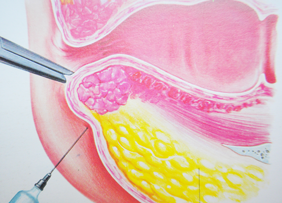Anal fissure treatment with laser
What is laser anal fissure surgery?
 laser anal fissure surgery is a surgical technique used to treat anal fissures, laser anal fissure treatment is a surgical alternative in the management of the fissure anal.
laser anal fissure surgery is a surgical technique used to treat anal fissures, laser anal fissure treatment is a surgical alternative in the management of the fissure anal.
Laser therapy is a recent technique for treating anal fissures and anal fistulas.
The technique used to treat anal fissure with laser is called FiLaC (Fistula-tract Laser Closure)
This technique consists of using a laser to close the anal fissure from the inside, the FiLaC technique is minimally invasive and can cause pain.
How does laser surgery for anal fissures work?
Laser anal fissure surgery works by using a laser to treat the anal fissure. Here's how it goes:
Laser treatment of anal fissure is a surgical alternative in the management of this condition.
The technique used to treat anal fissure with laser is called FiLaC (Fistula-tract Laser Closure).
The laser is used to close the anal fissure from the inside.
The laser is introduced into the anal fissure and is used to vaporize the surrounding tissue, thereby closing the fissure.
This technique is considered minimally invasive and may result in mild postoperative pain.
Benefits of laser surgery for anal fissures?
Benefits of laser surgery for anal fissures may include:
Surgical alternative: Laser treatment is a surgical alternative in the management of anal fissure.
Minimally invasive: The technique used to treat anal fissure with laser is considered minimally invasive.
Low postoperative pain: Laser anal fissure surgery can result in low postoperative pain.
Rapid recovery: The FiLaC technique may provide faster recovery than traditional surgery, with an average recovery time of 10 days.
Reduced risk of anal incontinence: The FiLaC technique can reduce the risk of anal incontinence.
Are there any risks associated with laser anal fissure surgery?
Laser anal fissure surgery can carry some risks. Here is some relevant information:
Risk of superinfection: There is a risk of superinfection of the anal fissure following surgery.
Risk factors: Certain factors can increase the risk of anal fissure, such as constipation. However, it is unclear whether these risk factors are specific to laser surgery or whether they also apply to other anal fissure treatments.
Comparison Between Traditional Surgery and Laser Surgery for Anal Fissures
Traditional surgery and laser surgery are two options for treating anal fissures.
Here are some differences between the two techniques:
Traditional surgery:
Traditional surgery for anal fissures may include fissurectomy, which involves removing the anal fissure.
This technique can lead to significant postoperative pain, anal incontinence and recurrence of the fissure.
Recovery time may be longer than for laser surgery.
Laser surgery:
Laser anal fissure surgery uses the FiLaC technique to close the anal fissure from the inside out using a laser.
This technique is considered minimally invasive and may result in low postoperative pain.
The FiLaC technique may provide faster recovery than traditional surgery, with an average recovery time of 9.5 days.
However, there can be complications with using laser to treat anal fissures, such as a extension of local care.
In summary, traditional surgery for anal fissures may include fissurectomy, which can lead to significant postoperative pain, anal incontinence, and recurrence of the fissure. Laser anal fissure surgery uses the FiLaC technique, which is considered minimally invasive and may result in low postoperative pain. The FiLaC technique may provide faster recovery than traditional surgery, but there may be complications with the use of laser, such as prolonged local care.
What is the success rate of laser surgery for anal fissures?
The success rate of laser surgery for anal fissures varies depending on the studies and the techniques used. Here are some search results:
Surgical anal fissure sealing technique, which uses laser, has a success rate of about 50%.
A study showed that the FiLaC (Fistula-tract Laser Closure) technique had a primary healing rate of 64, 1% to 75/117 cases.
Other studies have shown cure rates ranging from 70% to 80%.
A more recent study showed that for all fissures healing was 93%, with disorder very low continence and aggravation of postoperative pain.
In summary, the success rate of laser surgery for anal fissures varies depending on the studies and the techniques used. Research results show cure rates ranging from 50% to 93%, with significant differences between studies.
Recovery time
Recovery time after laser anal fissure surgery can vary depending on the patient and the techniques used. Full recovery with medical and surgical treatments can take up to about 6 to 10 weeks. Healing after anal fissure surgery takes about six weeks. One study assessed the pain score after laser surgery for chronic anal fissures, three weeks after the operation.
Is she painful?
Laser anal fissure surgery is painless. However, it is important to note that postoperative pain may vary between patients and the techniques used.